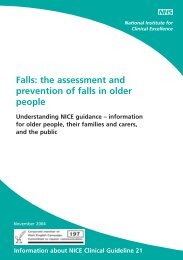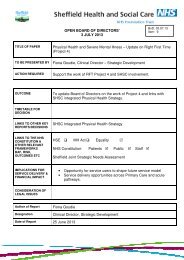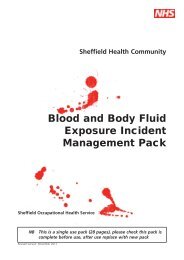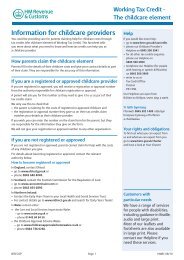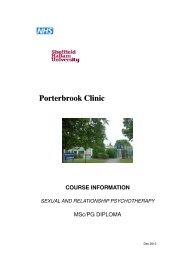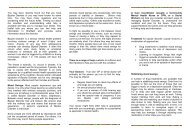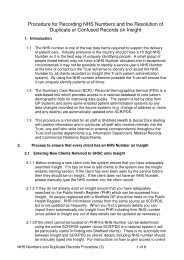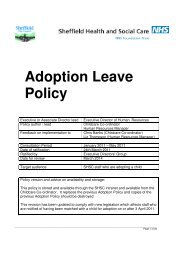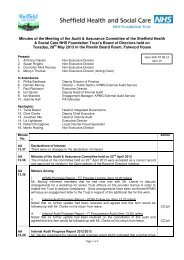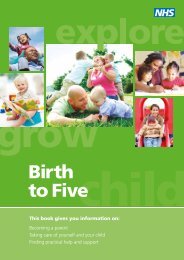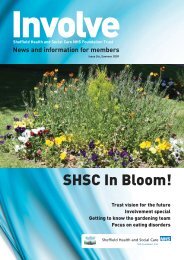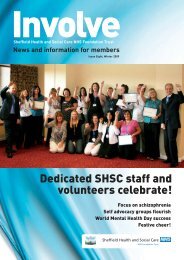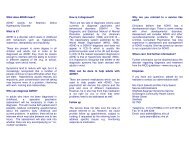Item 8 - Sheffield Health and Social Care
Item 8 - Sheffield Health and Social Care
Item 8 - Sheffield Health and Social Care
Create successful ePaper yourself
Turn your PDF publications into a flip-book with our unique Google optimized e-Paper software.
16.0 GlossaryAnnual AccountsDocuments prepared by the Trust to show itsfinancial position.Accounts Payable (Creditor)A supplier who has delivered goods or services inthe accounting period <strong>and</strong> has invoiced the Trust,but has not yet been paid.Accounts Receivable (Debtor)An organisation which has received a service fromthe Trust in the accounting period <strong>and</strong> has beeninvoiced by the Trust, but has not yet paid.Annual Governance StatementA statement about the controls the FT has in placeto manage risk.AssetSomething which is owned by the Trust. Forexample, a building or a piece of equipment, somecash or an amount of money owed to the Trust.BudgetRepresents the amount of money available fora service in a period of time <strong>and</strong> is compared toactual spend for the same period.Capital ExpenditureMoney spent on buildings <strong>and</strong> valuable pieces ofequipment such as major computer purchases.Cash Equivalent Transfer Value (Pensions)This is the total value of the pension schemebenefits accrued (i.e. saved up) which are thecontributions paid by a member of staff <strong>and</strong> theTrust over the period of employment. These fundsare invested <strong>and</strong> valued at a point in time by anactuary. The cash equivalent transfer value is theamount which would be transferred, if a staffmember moved to work for a different organisation.Current AssetsThese are assets, which are normally used ordisposed of within the financial year.Current LiabilitiesRepresents monies owed by the Trust that are dueto be paid in less than one year.Deferred IncomeFunding received from another organisation inadvance of when we will spend it.DepreciationAn accounting charge which represents the use,or wearing out, of an asset. The cost of an assetis spread over its useful life.Donated Asset ReserveThis represents the value of property, plant <strong>and</strong>equipment which has been, either donated to theTrust, or purchased from donated funds.EBITDAEarnings Before Interest, Tax Depreciation <strong>and</strong>Amortisation – this is a key indicator of financialperformance <strong>and</strong> profitability <strong>and</strong> indicates theability to pay the dividends due to the Governmentin respect of the 3.5% return on assets the Trust isexpected to achieve. The EBITDA is used to calculatesome of Monitor’s risk ratings.Going concernThe accounts are prepared on a going concern basiswhich means that the Trust expects to continue tooperate for at least the next 12 months.IFRS (International Financial Reporting St<strong>and</strong>ards)The professional st<strong>and</strong>ards Trusts must use fromApril 2009 when preparing the annual accounts.ImpairmentA decrease in the value of an asset.Income <strong>and</strong> Expenditure ReserveThis is an accumulation of transfers to / from theRevaluation Reserve as well as the cumulative surpluses<strong>and</strong> deficits reported by the Trust, including amountsbrought forward from when it was an NHS Trust.Intangible assetAn asset which is without substance, for example,computer software.InventoriesStocks such as clinical supplies.LiabilitySomething which the Trust owes, for example, a billwhich has not been paid.MEA (Modern Equivalent Asset)MonitorMonitor was established in January 2004 toauthorise <strong>and</strong> regulate NHS Foundation Trusts.Net Book ValueThe net book value is the lower of the cost to thebusiness to replace a fixed asset or the recoverableamount if the asset was sold (net of expenses).Non-current assets held for saleBuildings that are no longer used by the Trust <strong>and</strong>declared surplus by the Board, which are availablefor sale.Non-current asset or liabilityAn asset or liability which the Trust expects to holdfor longer than one year.Non-Executive DirectorThese are members of the Trust’s Board of Directors,however they do not have any involvement in theday-to-day management of the Trust. Their role isto provide the Board with independent challenge<strong>and</strong> scrutiny.Payment by ResultsA national tariff of fixed prices that reflect nationalaverage prices for hospital procedures. Already inuse in acute trusts <strong>and</strong> currently being developedfor mental health <strong>and</strong> learning disabilities services.Provisions for Liabilities <strong>and</strong> ChargesThese are amounts set aside for potential paymentsto third parties, which are uncertain in amount ortiming, for example, claims arising from litigation.Public Dividend CapitalThis is a type of public sector equity finance basedon the excess of assets over liabilities at the timeof the establishment of the predecessor NHS Trust.It is similar to a company’s share capital.Public Dividend Capital PayableThis is an amount paid to the Government forfunds made available to the Trust.Prudential Borrowing LimitAn NHS Foundation Trust is required to comply<strong>and</strong> remain within a prudential borrowing limit.This means that the total of borrowings by an NHSFoundation Trust from all sources must be containedwithin the borrowing limit set for it by Monitor inthe Terms of Authorisation.Reference CostThe costs of the Trust’s services are produced forthe Department of <strong>Health</strong> for comparison withother similar trusts.Revaluation ReserveThis represents the increase or decrease in thevalue of property, plant <strong>and</strong> equipment over itshistoric cost.Service Line ReportingA system which identifies income <strong>and</strong> expenditure<strong>and</strong> then produces gross profit across defined‘business units’, with the aim of improving quality<strong>and</strong> productivity.Statement of Cash FlowsShows the cash Flows in <strong>and</strong> out of the Trust duringthe period.Statement of Changes in Taxpayers’ EquityThis statement shows the changes in reserves <strong>and</strong>public dividend capital during the period.Statement of Comprehensive IncomeThis statement was previously called ‘Income<strong>and</strong> Expenditure Account’. It summarises theexpenditure on pay <strong>and</strong> non-pay running costs lessincome received, which results in a surplus or deficit.Statement of Financial PositionA year-end statement which provides a snapshotof the Trust’s financial position at a point in time.The top half shows the Trust’s total net assets(assets minus liabilities). The bottom half showsthe Taxpayers Equity or investment in the Trust.UK GAAP(Generally Accepted Accounting Practice)This was the st<strong>and</strong>ard basis of accounting in theUK before the international financial reportingst<strong>and</strong>ards were adopted.This is an instant build approach, using alternativesite valuation in some circumstances.195196



